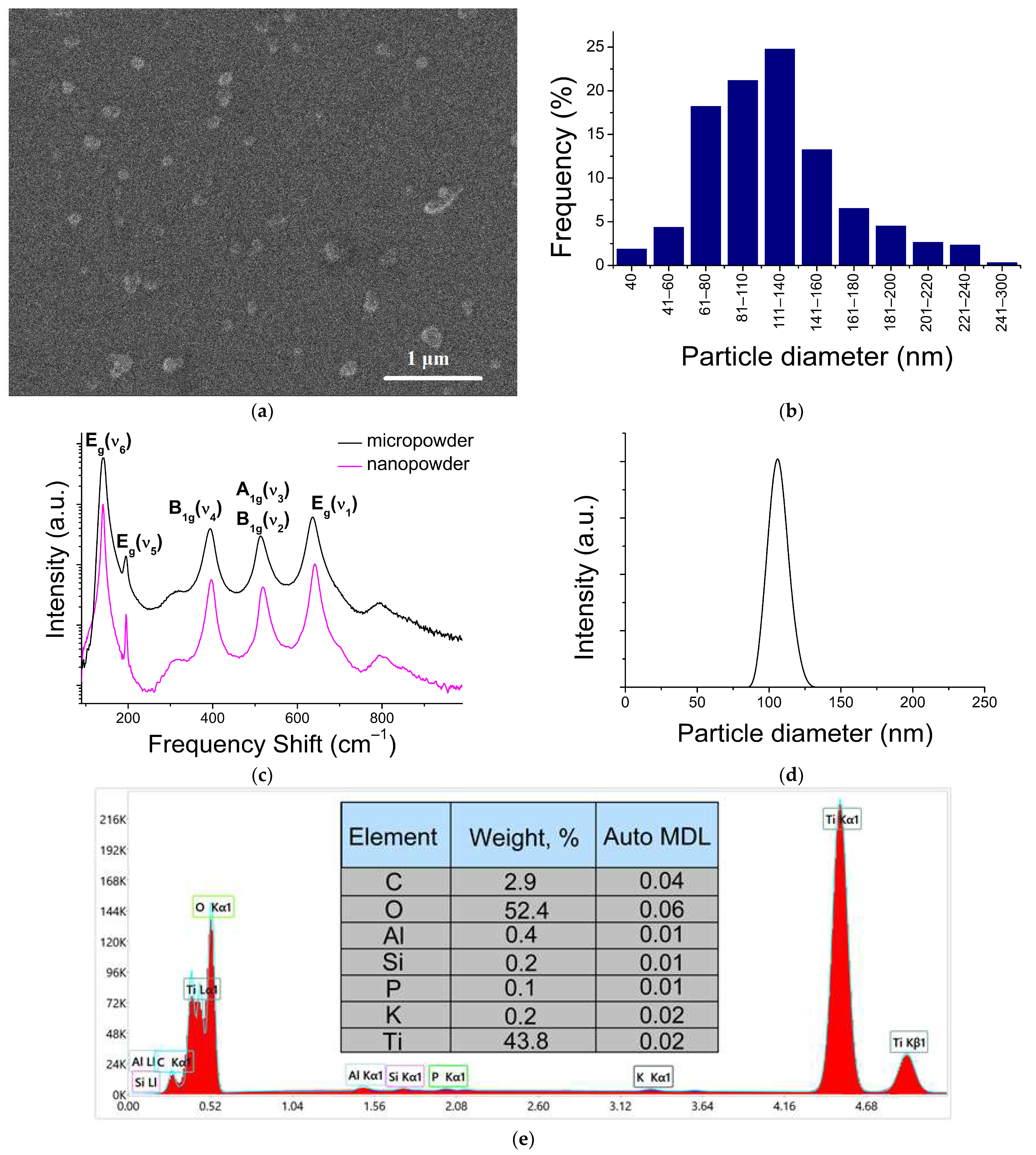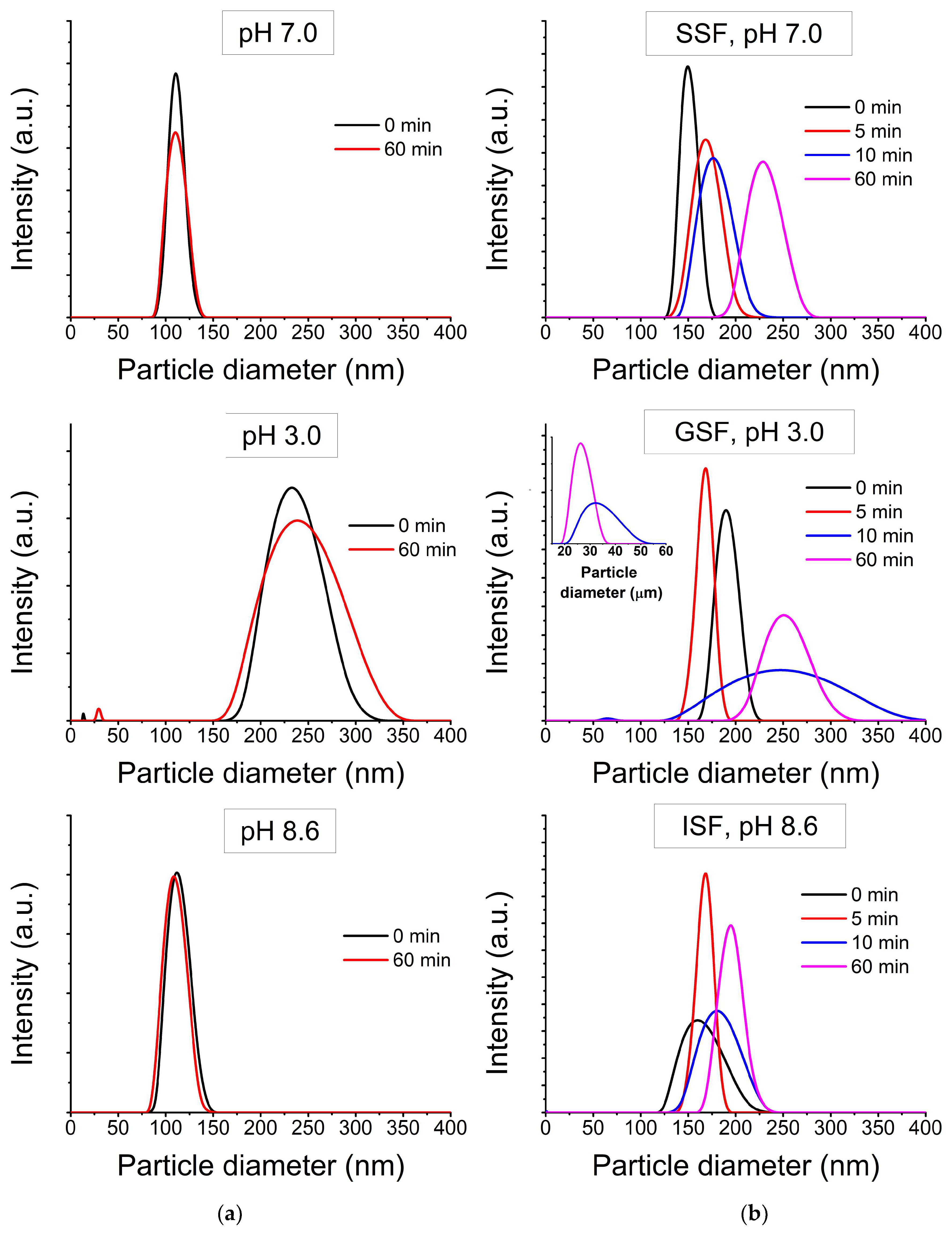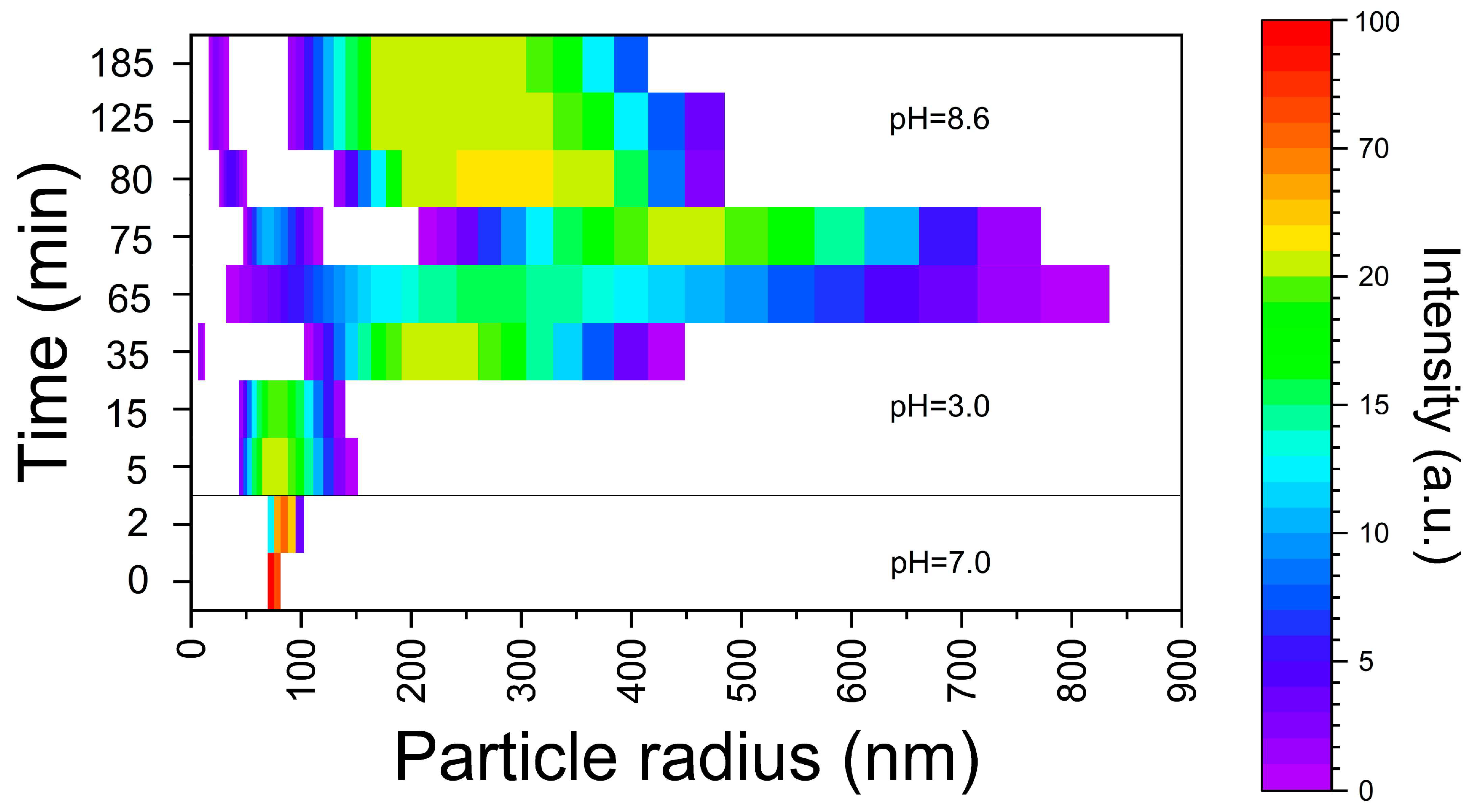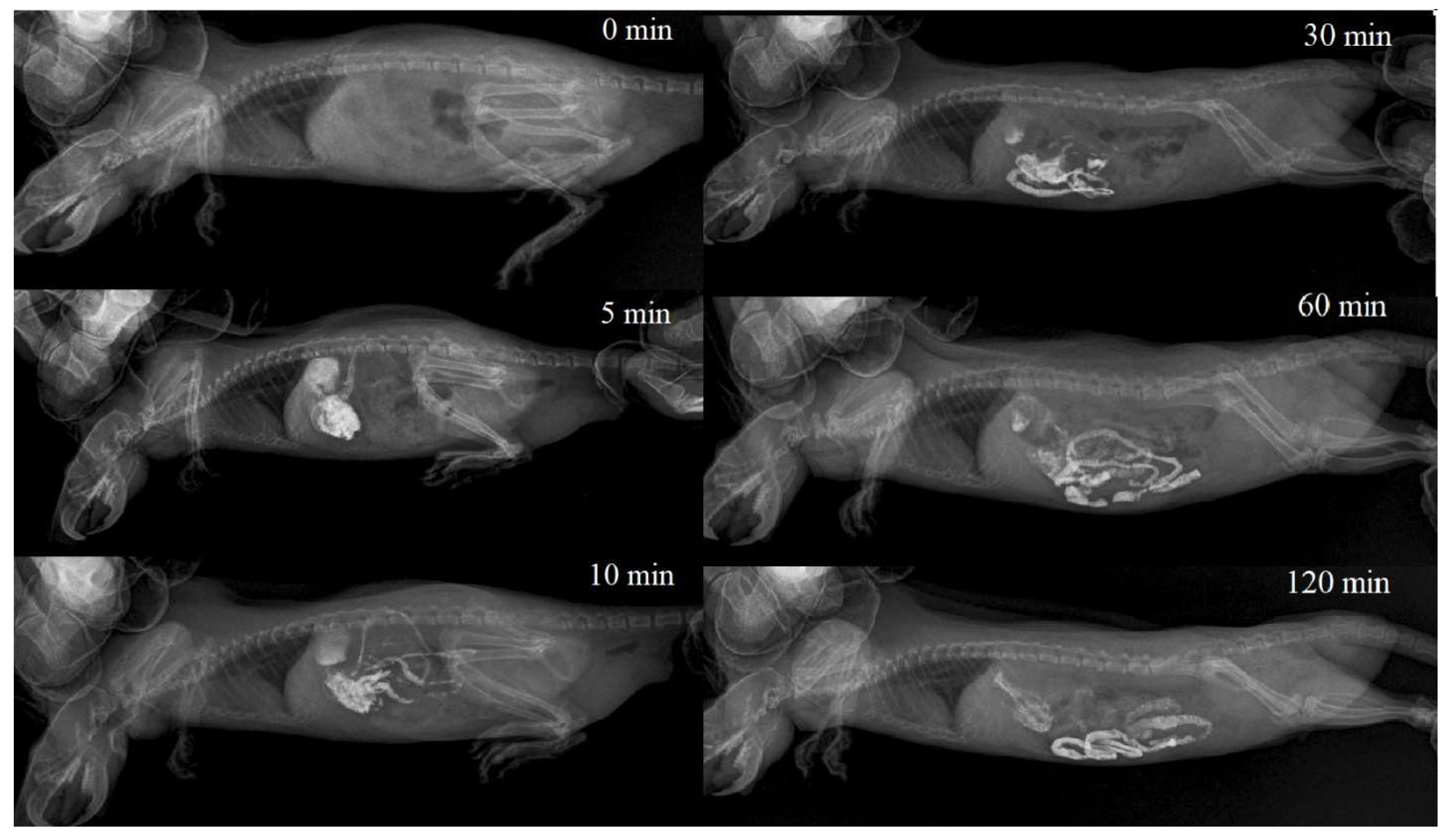Transformation of Nano-Size Titanium Dioxide Particles in the Gastrointestinal Tract and Its Role in the Transfer of Nanoparticles through the Intestinal Barrier
Abstract
:1. Introduction
2. Results
2.1. NPs Characterization
2.2. NPs Transformation at Separate Stages of Digestion
2.3. NPs’ Transformation in Conditions of Sequential Passing through a GIT Section
2.4. Gastrointestinal Transit Rate
3. Discussion
4. Materials and Methods
4.1. Materials
4.2. NPs Extraction
4.3. NPs’ Characterization
4.4. NPs’ Transformation in the GIT
4.5. Gastrointestinal Transit Rate
5. Conclusions
Author Contributions
Funding
Institutional Review Board Statement
Informed Consent Statement
Data Availability Statement
Acknowledgments
Conflicts of Interest
References
- Duan, Y.; Liu, J.; Ma, L.; Li, N.; Liu, H.; Wang, J.; Zheng, L.; Liu, C.; Wang, X.; Zhao, X.; et al. Toxicological characteristics of nanoparticulate anatase titanium dioxide in mice. Biomaterials 2010, 31, 894–899. [Google Scholar] [CrossRef]
- Ömelekoğlu, Ü.; Balli, E.; Yalin, S.; Eroğlu, P.; Bayrak, G.; Yaman, S.; Söğüt, F. Effects of different sizes silica nanoparticle on the liver, kidney and brain in rats: Biochemical and histopathological evaluation. J. Res. Pharm. 2019, 23, 344–353. [Google Scholar] [CrossRef]
- Gmoshinski, I.; Bagryantseva, O.; Khotimchenko, S. Toxicological and hygienic assessment of titanium dioxide nanoparticles as a component of E171 food additive (review of the literature and metahanalysis). Health Risk Anal. 2019, 2, 145–163. [Google Scholar] [CrossRef]
- Wu, M.; Chen, L.; Li, R.; Dan, M.; Liu, H.; Wang, X.; Wu, X.; Liu, Y.; Xu, L.; Xie, L. Bio-distribution and bio-availability of silver and gold in rat tissues with silver/gold nanorod administration. RSC Adv. 2018, 8, 12260–12268. [Google Scholar] [CrossRef]
- Binderup, M.-L.; Bredsdorff, L.; Beltoft, V.M.; Mortensen, A.; Löschner, K.; Löschner, K.; Larsen, E.H.; Eriksen, F.D. Systemic Absorption of Nanomaterials by Oral Exposure: Part of the ”Better Control of Nano” Initiative 2012–2015; Danish Environmental Protection Agency: Copenhagen, Denmark, 2013. [Google Scholar]
- Ryabtseva, M.S.; Krivobok, V.S.; Kolobov, A.V.; Dimitrieva, S.E.; Shevchenko, M.A.; Chentsov, S.I.; Nikolaeva, I.Y.; Tarnopolskaya, M.E. Relationship between the Physical Properties and Mechanisms of Toxic Action for Nanopowders and Micropowders of Titanium Dioxide in the Form of Anatase. Nanobiotechnol. Rep. 2022, 17, 846–856. [Google Scholar] [CrossRef]
- Gui, S.; Zhang, Z.; Zheng, L.; Cui, Y.; Liu, X.; Li, N.; Sang, X.; Sun, Q.; Gao, G.; Cheng, Z.; et al. Molecular mechanism of kidney injury of mice caused by exposure to titanium dioxide nanoparticles. J. Hazard. Mater. 2011, 195, 365–370. [Google Scholar] [CrossRef] [PubMed]
- Zhao, X.; Ze, Y.; Gao, G.; Sang, X.; Li, B.; Gui, S.; Sheng, L.; Sun, Q.; Cheng, J.; Cheng, Z.; et al. Nanosized TiO2-induced reproductive system dysfunction and its mechanism in female mice. PLoS ONE 2013, 8, e59378. [Google Scholar] [CrossRef] [PubMed]
- Vasantharaja, D.; Ramalingam, V.; Aadinaath, R.G. Oral toxic exposure of titanium dioxide nanoparticles on serum bio-chemical changes in adult male Wistar rats. Nanomed. J. 2015, 2, 46–53. [Google Scholar] [CrossRef]
- MacNicoll, A.; Kelly, M.; Aksoy, H.; Kramer, E.; Bouwmeester, H.; Chaudhry, Q. A study of the uptake and biodistribution of nano-titanium dioxide using in vitro and in vivo models of oral intake. J. Nanoparticle Res. 2015, 17, 66. [Google Scholar] [CrossRef]
- Peters, R.J.B.; van Bemmel, G.; Herrera-Rivera, Z.; Helsper, H.P.F.G.; Marvin, H.J.P.; Weigel, S.; Tromp, P.C.; Oomen, A.G.; Rietveld, A.G.; Bouwmeester, H. Characterization of titanium dioxide nanoparticles in food products: Analytical methods to define nanoparticles. J. Agric. Food Chem. 2014, 62, 6285–6293. [Google Scholar] [CrossRef]
- Horie, M.; Tabei, Y. Role of oxidative stress in nanoparticles toxicity. Free. Radic. Res. 2021, 55, 331–342. [Google Scholar] [CrossRef]
- Ivlieva, A.L.; Zinicovscaia, I.; Petritskaya, E.N.; Rogatkin, D.A. Nanoparticles and nanomaterials as inevitable modern toxic agents. Review. Part 2. Main areas of research on toxicity and techniques to measure a content of nanoparticles in tissues. Hum. Ecol. 2022, 29, 5–20. [Google Scholar] [CrossRef]
- Bettini, S.; Boutet-Robinet, E.; Cartier, C.; Coméra, C.; Gaultier, E.; Dupuy, J.; Naud, N.; Taché, S.; Grysan, P.; Reguer, S.; et al. Food-grade TiO2 impairs intestinal and systemic immune homeostasis, initiates preneoplastic lesions and promotes aberrant crypt development in the rat colon. Sci. Rep. 2017, 7, srep40373. [Google Scholar] [CrossRef]
- Baranowska-Wójcik, E.; Szwajgier, D.; Oleszczuk, P.; Winiarska-Mieczan, A. Effects of Titanium Dioxide Nanoparticles Exposure on Human Health—A Review. Biol. Trace Elem. Res. 2020, 193, 118–129. [Google Scholar] [CrossRef] [PubMed]
- Grissa, I.; ElGhoul, J.; Mrimi, R.; El Mir, L.; Ben Cheikh, H.; Horcajada, P. In deep evaluation of the neurotoxicity of orally administered TiO2 nanoparticles. Brain Res. Bull. 2020, 155, 119–128. [Google Scholar] [CrossRef]
- Wang, J.; Zhou, G.; Chen, C.; Yu, H.; Wang, T.; Ma, Y.; Jia, G.; Gao, Y.; Li, B.; Sun, J.; et al. Acute toxicity and biodistribution of different sized titanium dioxide particles in mice after oral administration. Toxicol. Lett. 2007, 168, 176–185. [Google Scholar] [CrossRef] [PubMed]
- Jani, P.U.; McCarthy, D.E.; Florence, A.T. Titanium dioxide (rutile) particle uptake from the rat GI tract and translocation to systemic organs after oral administration. Int. J. Pharm. 1994, 105, 157–168. [Google Scholar] [CrossRef]
- Wang, Y.; Chen, Z.; Ba, T.; Pu, J.; Chen, T.; Song, Y.; Gu, Y.; Qian, Q.; Xu, Y.; Xiang, K.; et al. Susceptibility of young and adult rats to the oral toxicity of titanium dioxide nanoparticles. Small 2012, 9, 1742–1752. [Google Scholar] [CrossRef]
- Cui, Y.; Liu, H.; Zhou, M.; Duan, Y.; Li, N.; Gong, X.; Hu, R.; Hong, M.; Hong, F. Signaling pathway of inflammatory responses in the mouse liver caused by TiO2 nanoparticles. J. Biomed. Mater. Res. Part A 2011, 96 Pt A, 221–229. [Google Scholar] [CrossRef]
- Cho, W.-S.; Kang, B.-C.; Lee, J.K.; Jeong, J.; Che, J.-H.; Seok, S.H. Comparative absorption, distribution, and excretion of titanium dioxide and zinc oxide nanoparticles after repeated oral administration. Part. Fibre Toxicol. 2013, 10, 9. [Google Scholar] [CrossRef]
- Mohammadi, P.; Sheibani, H. Green synthesis of Fe3O4@SiO2-Ag magnetic nanocatalyst using safflower extract and its application as recoverable catalyst for reduction of dye pollutants in water. Appl. Organomet. Chem. 2018, 32, e4249. [Google Scholar] [CrossRef]
- Givens, B.E.; Xu, Z.; Fiegel, J.; Grassian, V.H. Bovine serum albumin adsorption on SiO2 and TiO2 nanoparticle surfaces at circumneutral and acidic pH: A tale of two nano-bio surface interactions. J. Colloid Interface Sci. 2017, 493, 334–341. [Google Scholar] [CrossRef] [PubMed]
- Zhou, H.; McClements, D.J. Recent Advances in the Gastrointestinal Fate of Organic and Inorganic Nanoparticles in Foods. Nanomaterials 2022, 12, 1099. [Google Scholar] [CrossRef]
- Minekus, M.; Alminger, M.; Alvito, P.; Ballance, S.; Bohn, T.; Bourlieu, C.; Carrière, F.; Boutrou, R.; Corredig, M.; Dupont, D.; et al. A standardised static in vitro digestion method suitable for food—An international consensus. Food Funct. 2014, 5, 1113–1124. [Google Scholar] [CrossRef]
- Behzadi, S.; Serpooshan, V.; Tao, W.; Hamaly, M.A.; Alkawareek, M.Y.; Dreaden, E.C.; Brown, D.; Alkilany, A.M.; Farokhzad, O.C.; Mahmoudi, M. Cellular uptake of nanoparticles: Journey inside the cell. Chem. Soc. Rev. 2017, 46, 4218–4244. [Google Scholar] [CrossRef] [PubMed]
- Marucco, A.; Prono, M.; Beal, D.; Alasonati, E.; Fisicaro, P.; Bergamaschi, E.; Carriere, M.; Fenoglio, I. Biotransformation of Food-Grade and Nanometric TiO2 in the Oral–Gastro–Intestinal Tract: Driving Forces and Effect on the Toxicity toward Intestinal Epithelial Cells. Nanomaterials 2020, 10, 2132. [Google Scholar] [CrossRef]
- Shevchenko, M.A.; Umanskaya, S.F.; Krivobok, V.S.; Kolobov, A.V.; Dimitrieva, S.E.; Chentsov, S.I. Effect of Active Acidity of a Colloidal Solution of Titanium Dioxide in the Form of Anatase on the Aggregate Stability of Nanofraction. Bull. Lebedev Phys. Inst. 2021, 48, 250–255. [Google Scholar] [CrossRef]
- Gubin, M.M. Domestic X-ray contrast agent BAR-VIPS and methods of radiation diagnosis of diseases of the colon. Radiol. Pract. 2012, 3, 83–90. (In Russian) [Google Scholar]
- Bajka, B.H.; Rigby, N.M.; Cross, K.L.; Macierzanka, A.; Mackie, A.R. The influence of small intestinal mucus structure on particle transport ex vivo. Colloids Surf. B Biointerfaces 2015, 135, 73–80. [Google Scholar] [CrossRef] [PubMed]
- Meldrum, O.W.; Yakubov, G.E.; Bonilla, M.R.; Deshmukh, O.; McGuckin, M.A.; Gidley, M.J. Mucin gel assembly is controlled by a collective action of non-mucin proteins, disulfide bridges, Ca2+-mediated links, and hydrogen bonding. Sci. Rep. 2018, 8, 5802. [Google Scholar] [CrossRef]
- Zhu, X.; Zhao, L.; Liu, Z.; Zhou, Q.; Zhu, Y.; Zhao, Y.; Yang, X. Long-term exposure to titanium dioxide nanoparticles promotes diet-induced obesity through exacerbating intestinal mucus layer damage and microbiota dysbiosis. Nano Res. 2021, 14, 1512–1522. [Google Scholar] [CrossRef]
- Quini, C.C.; Américo, M.F.; Corá, L.A.; Calabresi, M.F.; Alvarez, M.; Oliveira, R.B.; Miranda, J.A. Employment of a noninvasive magnetic method for evaluation of gastrointestinal transit in rats. J. Biol. Eng. 2012, 6, 6. [Google Scholar] [CrossRef] [PubMed]
- Perry, R.L.; Carrig, C.B.; Williams, J.F.; Johnson, C.A.; Kaneene, J.B. Anatomic features and radiographic observations of gastric emptying and small intestinal motility in the rat. Lab. Anim. Sci. 1993, 43, 586–593. [Google Scholar]
- Purdon, R.; Bass, P. Gastric and Intestinal Transit in Rats Measured by a Radioactive Test Meal. Gastroenterology 1973, 64, 968–976. [Google Scholar] [CrossRef] [PubMed]
- Vancamelbeke, M.; Vermeire, S. The intestinal barrier: A fundamental role in health and disease. Expert Rev. Gastroenterol. Hepatol. 2017, 11, 821–834. [Google Scholar] [CrossRef]




Disclaimer/Publisher’s Note: The statements, opinions and data contained in all publications are solely those of the individual author(s) and contributor(s) and not of MDPI and/or the editor(s). MDPI and/or the editor(s) disclaim responsibility for any injury to people or property resulting from any ideas, methods, instructions or products referred to in the content. |
© 2023 by the authors. Licensee MDPI, Basel, Switzerland. This article is an open access article distributed under the terms and conditions of the Creative Commons Attribution (CC BY) license (https://creativecommons.org/licenses/by/4.0/).
Share and Cite
Ryabtseva, M.S.; Umanskaya, S.F.; Shevchenko, M.A.; Krivobok, V.S.; Kolobov, A.V.; Nastulyavichus, A.A.; Chentsov, S.I.; Sibirtsev, V.D. Transformation of Nano-Size Titanium Dioxide Particles in the Gastrointestinal Tract and Its Role in the Transfer of Nanoparticles through the Intestinal Barrier. Int. J. Mol. Sci. 2023, 24, 14911. https://doi.org/10.3390/ijms241914911
Ryabtseva MS, Umanskaya SF, Shevchenko MA, Krivobok VS, Kolobov AV, Nastulyavichus AA, Chentsov SI, Sibirtsev VD. Transformation of Nano-Size Titanium Dioxide Particles in the Gastrointestinal Tract and Its Role in the Transfer of Nanoparticles through the Intestinal Barrier. International Journal of Molecular Sciences. 2023; 24(19):14911. https://doi.org/10.3390/ijms241914911
Chicago/Turabian StyleRyabtseva, M. S., S. F. Umanskaya, M. A. Shevchenko, V. S. Krivobok, A. V. Kolobov, A. A. Nastulyavichus, S. I. Chentsov, and V. D. Sibirtsev. 2023. "Transformation of Nano-Size Titanium Dioxide Particles in the Gastrointestinal Tract and Its Role in the Transfer of Nanoparticles through the Intestinal Barrier" International Journal of Molecular Sciences 24, no. 19: 14911. https://doi.org/10.3390/ijms241914911
APA StyleRyabtseva, M. S., Umanskaya, S. F., Shevchenko, M. A., Krivobok, V. S., Kolobov, A. V., Nastulyavichus, A. A., Chentsov, S. I., & Sibirtsev, V. D. (2023). Transformation of Nano-Size Titanium Dioxide Particles in the Gastrointestinal Tract and Its Role in the Transfer of Nanoparticles through the Intestinal Barrier. International Journal of Molecular Sciences, 24(19), 14911. https://doi.org/10.3390/ijms241914911




